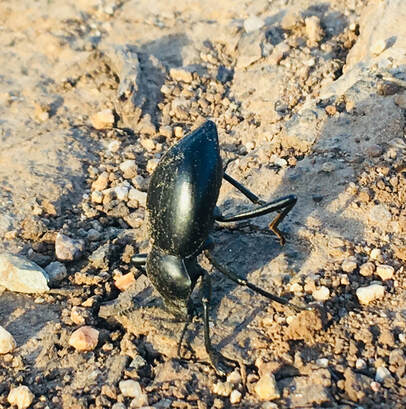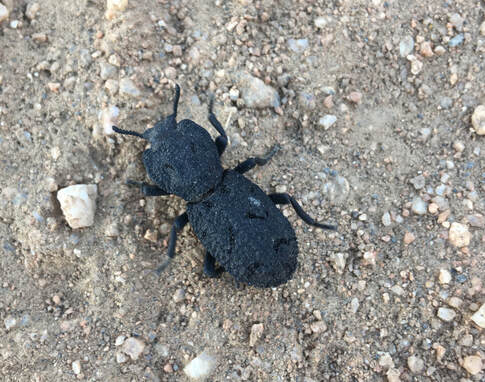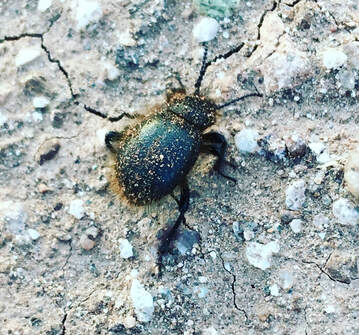by Dani Ruais, Ph.D. Student
My first real introduction to darkling beetles was earlier this year when I was tasked to care for the UCR Entomology department living insect collection used for outreach. I was the caretaker of several species of darkling beetles, all cloistered together in a sand-filled terrarium.
Don’t get me wrong - I had seen darkling beetles before in the wild, hiking paths of the southern California desert where they are numerous. You may know them commonly as “stinkbugs.” Some of these beetles in the Eleodes genus do emit noxious odors in the chemical class quinones from the ends of their abdomens or behind their heads as a defensive mechanism. These darkling beetles are often called head-stander beetles or clown beetles because they stick their rears up in the air when threatened. Most wild animals such as owls and snakes learn to steer clear of these beetles. However, some predators such as grasshopper mice have developed the curious tactic of grabbing the beetle and immediately shoving its rear end into the sand in order to start eating it head first.
My first real introduction to darkling beetles was earlier this year when I was tasked to care for the UCR Entomology department living insect collection used for outreach. I was the caretaker of several species of darkling beetles, all cloistered together in a sand-filled terrarium.
Don’t get me wrong - I had seen darkling beetles before in the wild, hiking paths of the southern California desert where they are numerous. You may know them commonly as “stinkbugs.” Some of these beetles in the Eleodes genus do emit noxious odors in the chemical class quinones from the ends of their abdomens or behind their heads as a defensive mechanism. These darkling beetles are often called head-stander beetles or clown beetles because they stick their rears up in the air when threatened. Most wild animals such as owls and snakes learn to steer clear of these beetles. However, some predators such as grasshopper mice have developed the curious tactic of grabbing the beetle and immediately shoving its rear end into the sand in order to start eating it head first.
The term “darkling beetle” refers to several genera within the insect family Tenebrionidae which include about 20,000 species. They can also be referred to as “pinacate beetles.” They are found worldwide but are most commonly encountered in the deserts of the western United States, with as many as 450 species in California alone. Typically, they can be found under stones, around decaying matter, or walking right out in the open.
These beetles can serve as great pets - even for children! They don’t move too fast, they are durable and resilient when dropped due to their hardened outer shell called elytra. They don’t usually bite when bothered and can be conditioned to handling by humans. Some will survive for a few years in captivity and even reproduce. And they are all around beautiful beetles! Darklings are omnivorous scavengers, often feeding on rotting leaves and dead animals in the wild. However, in captivity, they can be fed fruits and vegetables or even dry pet food. Many beetles are reared for their larval state: the mealworm, which are used to feed pet reptiles and birds.
These beetles can serve as great pets - even for children! They don’t move too fast, they are durable and resilient when dropped due to their hardened outer shell called elytra. They don’t usually bite when bothered and can be conditioned to handling by humans. Some will survive for a few years in captivity and even reproduce. And they are all around beautiful beetles! Darklings are omnivorous scavengers, often feeding on rotting leaves and dead animals in the wild. However, in captivity, they can be fed fruits and vegetables or even dry pet food. Many beetles are reared for their larval state: the mealworm, which are used to feed pet reptiles and birds.
Ironclad beetles are also common in Southern California. They are part of the family Zopheridae which is nested within the superfamily Tenebrionoidea (which includes darkling beetles). These beetles have one of the hardest arthropod exoskeletons, hence their name. They also have a reputation of “playing dead” when disturbed. I’ve heard many tales of young entomologists collecting ironclad beetles, and thinking they were dead, pinned them in their arthropod collections. Only days or even weeks later, did the students notice their ironclad specimen was gone, or was walking around the box with a pin pierced through its elytra. These beetles are slow moving, flightless, and can often go a month or more without food or water.
Perhaps my favorite of the darkling beetles is the wooly darkling beetle (pictured below), Eleodes osculans. They are covered in fine reddish-orange hairs. Although most of the literature describes them as a nocturnal species, they seem to be crepuscular as I do notice quite a few of them, at least in Southern California, out and about an hour or two before sunset. Plan your hikes accordingly so that you can catch them when the sun highlights their fuzzy bodies!
For more information on breeding or identifying darkling beetles, check out:
- Borror, D. J., & White, R. E. (1970). A field guide to the insects of America north of Mexico. Houghton Mifflin Company, Boston, Massachusetts, USA.
- Jaggard, V. (2015). Meet the makech, the bedazzled beetles worn as living jewelry. SmithsonianMag.com. https://www.smithsonianmag.com/smithsonian-institution/meet-makech-bedazzled-beetles-worn-living-jewelry-180955081/ (accessed 02.16.20).
- McMonigle, O. (2012). The Ultimate Guide to Breeding Beetles: Coleoptera Laboratory Culture Methods. Coachwhip Publications. Landisville, Pennsylvania, USA.
- www.bugguide.net
- www.desertusa.com/insects/stinkbug




 RSS Feed
RSS Feed
